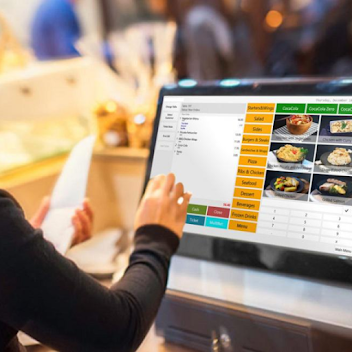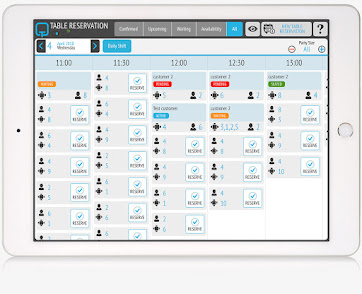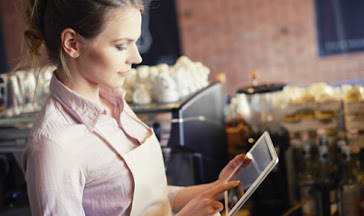- Get link
- X
- Other Apps
- Get link
- X
- Other Apps
Restaurants have come to a lengthy method from the days of duty bells and waitresses on roller skates, so why does your cash record seem like it was created by Ben Franklin?
 |
| how to use pos system restaurant |
Restaurant Point of Sale (POS) systems
Restaurant Point of Sale (POS) systems are transforming the system restaurants work, fetching data from the back of the house to the servers, cashiers, and greeters at the front. They can allow you to receive payments from just about anyplace in your restaurant – at the front, at the exit, or even online. Unifying these wage streams is perilous, particularly when you recognize online ordering has increased by up to 3,868% in some areas since February.
In this article, we’ll incorporate how to use a POS system in a restaurant, how they develop your restaurant’s performance, and how to estimate which one works most beneficial for your requirements.
Contents About
- What is a restaurant POS system?
- How do you use a POS system in a restaurant?
- How does a restaurant POS system help your business?
- Reservations and seating in your POS system
- Front of house and back of house communication through a POS system
- POS systems and food preparation
- Minimizing food waste and theft
- Menu optimization
- Staff and restaurant performance reporting
- How to pick a POS system
 |
| Restaurant POS System |
What is a restaurant POS system?
A restaurant POS system is an elegant name for the system that allows debit or credit card payments. Your POS is, in different words, where your consumers pay for your assistance. It can be at the counter, at the table, or even online. Modern POS systems trace payments, receipts, inventory, consumer, and sales data, and can also assist you to lead your employees.
Otherwise known as the point of buying, the cash entry was traditionally placed near the exit so consumers could spend on their method. As restaurants, and further, the concept of dining, have switched, the thought of the point of sale has evolved with it, providing for more freedom and flexibility in phrases of where consumers can pay – and where restaurants can collect their money.
In most restaurants now, POS systems are the primary processing unit for pretty much all data moving into and out of the business. Each financial activity is registered at the point of sale, and your POS system can combine that data with your list, cross-reference it with your menu objects, and generate accurate financial reports cut up in simply about any way you can assume.
 |
| How do you use a POS system in a restaurant |
How do you use a POS system in a restaurant?
You can utilize a POS system for a kind of function behind taking your customer’s money. POS systems can be applied for:
- Fast ordering
- Data security
- Inventory management
- Financial reporting
- Menu optimization
- Staff scheduling and control
And so much more. To take full benefits of your POS system, you should blend it with as numerous operations as you can, including your record management platform, your staff management solutions, and your financial management system. Integrations are truly where POS systems shine the most glorious, and where they can do the greatest for your business. Efreshh, for instance, can blend with your POS to help unite your inventory supply chain and food services with your sales and finances.
How does a restaurant POS system help your business?
POS systems can assist streamline your restaurant’s works, and ally your restaurant front of house and back of house duties in one easy-to-use system. POS systems can assist with bookings, front of house and back of house communication, food preparation, waste and theft decrease, menu optimization, and performance reporting.
 |
| reservations and seating in your pos system |
Image Source: Till point
Reservations and Seating in your POS system
Taking bookings is one of the more complex sections of the customer experience: plans change, accidents happen, and sometimes your 6 pm party of four is really a party of seven.
In the old days, restaurants would hold a paper book with bookings beside a laminated floor plan to arrange the seat. By the end of your ordinary Friday night, the list would be scribbled over and rewritten, and the floor plan would be so smudged with the felt marker you could hardly make out what was a name and what was a table.
Modern POS systems can combine your bookings from phone and online bookings, allowing you to trade tables, names, and times with ease. This gets the burden off your serving and waiting for the crew when bookings remove or switch.
You’ll be able to make universal turns on one tablet or computer, so everyone can visit in the loop as to who’s sitting at a big top, what family is sharing the mozzarella sticks, and who no-showed their anniversary banquet.
Front of house and back of house communication through a POS system
All restaurants require a system to accept orders for the kitchen and bar and distribute those orders with chefs, servers, and bussers. Traditionally, front-of-house and back-of-house restaurant ops move very separately, given the nature of their duties. Because of that, it’s simple for breakdowns in information to occur, as the workflows have several things happening at another time.
POS systems can assist explain this process – Having waiters scribbling down orders, escorting them to the kitchen, and responding to questions from the chef leaves a lot of room for mistakes and miscommunication.
Serves and waiters can record orders straight into your POS system with marks and comments, so chefs can get them while the order is placed. Some restaurants have tablets or other devices to enable staff to input orders as they wait on consumers, while others provide consumers the tablets to let them order themselves.
POS systems and food preparation
Measuring food expenses is one of the best methods you can maintain tabs on your restaurant’s health, but have you always attempted doing it by hand? Luckily for you, we left that back with turning phones and floppy disks.
Most POS systems are composed to trace your inventory, as well as ingredients utilized for every menu item. So when your server types in “1 burger with no cheese, double pickles” your inventory will display those adjustments.
To stay on the head of your food expenses, you require proper data that POS systems can present, so nothing can slip through the cracks. If you’re not getting sufficient capital on a high menu item, you’ll be capable of seeing it through real-time reports from your POS.
Additionally, several POS systems integrate with your inventory management system so you can streamline the method even further – that means when that twin pickle burger empties your last jar of Vlasic, you can schedule an order quickly. In addition, data obtained by your POS will assist you to estimate discrepancies between your recipes, orders, and actual inventory, so you can recognize areas of waste, theft, or where you can just take a little more efficiently.
 |
| Minimizing food waste and theft |
Image Source: Amazonaws
Minimizing food waste and theft
You’ve seemingly heard the saying: “What gets mapped, gets handled,” and that couldn’t be more accurate for the restaurant business. A POS system, integrated with a restaurant inventory management platform, can enable you to trace food costs and food waste throughout the regular course of business.
You’ll be capable of distinguishing inventory received from your suppliers, as well as invoices, with exact usage and order to detect any errors and areas for growth. By tracking your inventory in tandem with sales, you can obtain helpful insight into where your services can be enhanced.
After all, food waste doesn’t just harm the environment, it’s one of the greatest causes restaurants fail. Small, personal costs from food waste can sum up very speedily, siphoning away money needlessly. Whether it’s because your pieces are too big or your prep cooks aren’t utilizing ingredients effectively, food waste is an exorbitant debt that can get out of hand just as simply it can be managed.
On another record, employee theft is an unhappy reality for numerous restaurants. Since things are so restless in the kitchen, it can sometimes be difficult to tell when someone’s flying off the top. A few bites here and an additional steak there can sum up to serious trials over time, chiefly when you think about the profit edges of most restaurants. Paring POS data with inventory management data can assist you to hold down robbers before they can steal you blind.
Therefore, a POS system, integrated with your inventory management platform, is essential to running a restaurant in 2021.
Menu Optimization
If you can’t recognize it by now, a POS system can sincerely enhance your inventory management game. One of the most important steps it can do is by providing you data to optimize your menu. Traditionally, you’d have to hold an eye on how much people are consuming and alter prices incrementally to optimize your costs, menu choices, and serving capacities.
With a POS system, you can whittle down a week's value of work into several minutes. You’ll be able to see selected dishes, classify weak points in your menu, and cross-reference them with sales data and food expenses. You’ll eliminate all the guesswork and modify pricing and menu order on the fly, creating menu settings less of an analysis and more of a science.
Also, by joining sales information with inventory and food waste expenses, you’ll be able to see what menu things aren’t deserving of the money, and which recipes can be modified without shaking the boat.
Staff and restaurant performance reporting
Your POS system can assist you to trace key employee metrics like sales per operator, average tips, attendance, and more. You can also track things like the number of customers assisted, table turnover, and the number of fresh consumers seated on any temporary basis.
Analyzing employee and restaurant-related statistics weekly, monthly, and annually through your POS can assist you to linger at the head of your restaurant’s financial health, manage team performance, and take a step to raise performance across the board. Capturing this data is crucial to be prepared to handle your front of house and back of house employees, providing you with relevant, timely, and accurate reporting data to make conclusions about staffing and more.
Also, your POS system will enable you to obtain your restaurant more efficiently in each area. For instance, if you know your average time to place is over 20 minutes, your average time to the course is over an hour, and your average consumer visit is an hour and a half, you can assume that you require some serious efficiency modifications.
Without a POS system, you’d have to have tags on this yourself, recording this data by hand, or having your administrators keep an eye out. Through a POS system, you can handle all of this immediately, and modify your plans, seating, and staffing in a part of the time.
 |
| how to pick a POS system |
How to pick a POS system
There are many several POS systems, with tons of specialties, add-ons, and integrations – but not all are equivalent. To discover the one that operates best for your restaurant, converge on the necessary measures. Ask yourself these questions:
- Does it take credit and debit transactions in my location?
- Can it integrate with my additional software?
- Does it have the reporting metrics I require?
Integrations and reporting are clear differentiators for your POS system. Part of what gives them so powerful is that the data can be utilized across your restaurant’s works to power up your decision-making. POS systems that can integrate with inventory management platforms, for instance, can take out the guesswork in inventory management, menu optimization, and so many more. You’ll have all the data at your fingertips for estimating food expenses, adjusting menu prices, and addressing food waste.
You can also trace inventory over the board, from the moment someone orders a burger to the time a prep cook opens up an extra package of ground beef. An integrated POS system can provide you whole control over your food stock and sales process. Efreshh offers an industry-leading inventory management system that seamlessly integrates with almost any POS system to assist you to obtain the most of your restaurant, and spends less time bothering about the numbers and more time doing what you love. To learn more about what Efreshh can do for you, ask for a demo or contact us today.
Comments
Post a Comment